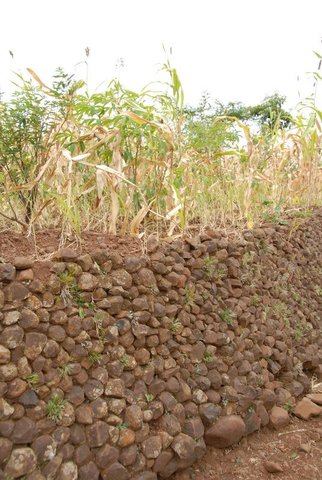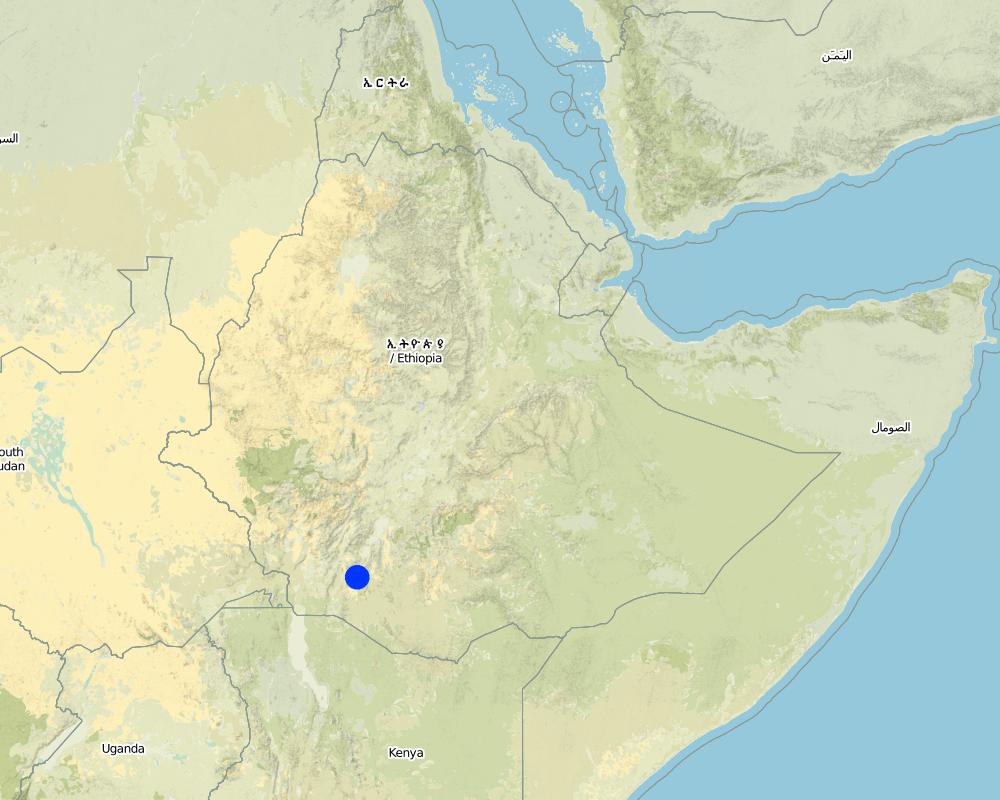Labour exchange [Ethiopia]
- Creation:
- Update:
- Compiler: Unknown User
- Editor: –
- Reviewer: Fabian Ottiger
approaches_2674 - Ethiopia
View sections
Expand all Collapse all1. General information
1.2 Contact details of resource persons and institutions involved in the assessment and documentation of the Approach
1.3 Conditions regarding the use of data documented through WOCAT
The compiler and key resource person(s) accept the conditions regarding the use of data documented through WOCAT:
Yes
1.4 Reference(s) to Questionnaire(s) on SLM Technologies

Konso Bench Terrace [Ethiopia]
It is a stone wall embankment along the contour with land leveling in between two terrace walls to control erosion.
- Compiler: Daniel Danano
2. Description of the SLM Approach
2.1 Short description of the Approach
It is an approach based on labour exchange organized on the basis of mutual assistance involving no payment for work done. However, the land user is supposed to provide people participating with food and drinks. All wanting such cooperation request the me
2.2 Detailed description of the Approach
Detailed description of the Approach:
Aims / objectives: To alleviate the labour shotage each member of the labour exchange group could request for assistance any time farm activities need to be performed. The objective of the approach is to strengthen the relationship among the community members. It is further intended to make the community members share experience, skills and technical know-how on soil and water conservation activities.
Role of stakeholders: A farmer request individuals from the community members to get support.The request is made ahead of time in informing individual farmers about the programme (one to two weeks ahead) so that participants get enough time to prepare. The farmer who seeks assistance should prepare food and local drinks. And in the mean time, the farmer has to remind those who are requested for help so that all invited farmers participate. The participants avail themselves on the specified date with all necessary farm implements required for the activity. In this approach particularly for soil and water conservation activities participants shold be men. For weeding and harvesting women involve more than men because they can carry more weights than men.
2.5 Country/ region/ locations where the Approach has been applied
Country:
Ethiopia
Region/ State/ Province:
Konso, SNNPR
Map
×2.7 Type of Approach
- traditional/ indigenous
2.8 Main aims/ objectives of the Approach
The Approach focused mainly on other activities than SLM (Approach is used mostly on activites like land preparation, sowing and weeding. Community members help each other in contributing labour contributing labour on the basis of mutual understanding)
To solve the labour constraints faced by that some members of the community.
The SLM Approach addressed the following problems: Shortage of labour
2.9 Conditions enabling or hindering implementation of the Technology/ Technologies applied under the Approach
availability/ access to financial resources and services
- hindering
Lack of finance to hire labour
Treatment through the SLM Approach:
legal framework (land tenure, land and water use rights)
- enabling
The practice has been there before the existing land ownership policy came into existance and it still exists after it.
other
- hindering
Shortage of grain. A farmer to benefit from labour exchange he has to have enough food crop in which he can make food and drink.
Treatment through the SLM Approach:
3. Participation and roles of stakeholders involved
3.1 Stakeholders involved in the Approach and their roles
- local land users/ local communities
Men mainly undertake SWC activities but women equally take part in other farm activities.
According to the farmers view men are wise (have more wisdom on indegenous technical knowledge than women). The SWC work is tedious and requires more energy to perform. No significant difference among different classes or status in the community in dicision making because the approach is mainly designed to help those who require labour assisstance for their farm activities.
3.2 Involvement of local land users/ local communities in the different phases of the Approach
| Involvement of local land users/ local communities | Specify who was involved and describe activities | |
|---|---|---|
| initiation/ motivation | none | |
| planning | none | |
| implementation | none | |
| monitoring/ evaluation | none | |
| Research | none |
3.4 Decision-making on the selection of SLM Technology/ Technologies
Specify who decided on the selection of the Technology/ Technologies to be implemented:
- land users alone (self-initiative)
Explain:
land user driven (bottom-up)
Decisions on the method of implementing the SLM Technology were made by by land users* alone (self-initiative / bottom-up). land user driven (bottom-up)
4. Technical support, capacity building, and knowledge management
4.3 Institution strengthening (organizational development)
Have institutions been established or strengthened through the Approach?
- no
5. Financing and external material support
5.2 Financial/ material support provided to land users
Did land users receive financial/ material support for implementing the Technology/ Technologies?
Yes
5.3 Subsidies for specific inputs (including labour)
- none
If labour by land users was a substantial input, was it:
- voluntary
Comments:
Local food and drink after work
5.4 Credit
Was credit provided under the Approach for SLM activities?
No
6. Impact analysis and concluding statements
6.1 Impacts of the Approach
Did the Approach help land users to implement and maintain SLM Technologies?
- No
- Yes, little
- Yes, moderately
- Yes, greatly
Since the practice has evolved locally the farmers have no problem in practicing it.
Did the Approach improve issues of land tenure/ user rights that hindered implementation of SLM Technologies?
- No
- Yes, little
- Yes, moderately
- Yes, greatly
The approach has no relation with land ownership or land use rights.
Did other land users / projects adopt the Approach?
- No
- Yes, little
- Yes, moderately
- Yes, greatly
6.3 Sustainability of Approach activities
Can the land users sustain what has been implemented through the Approach (without external support)?
- yes
6.4 Strengths/ advantages of the Approach
| Strengths/ advantages/ opportunities in the land user’s view |
|---|
| The one who had few children to help him in farm activities benefited more from the system |
| Created a better understanding on labour exchange among the community |
| Strengths/ advantages/ opportunities in the compiler’s or other key resource person’s view |
|---|
| Labour problem alleviated (How to sustain/ enhance this strength: The system by it self is sustainable because it has evolved and developed with in the community.) |
| All farming activities can be accomplished according to their seasonal calender |
| Every member of the community has got awarness on each farm activities |
| Social relationship among the communit becames stronger |
| The farmers can cope up adverse environmental conditions |
6.5 Weaknesses/ disadvantages of the Approach and ways of overcoming them
| Weaknesses/ disadvantages/ risks in the land user’s view | How can they be overcome? |
|---|---|
| To some extent the system favours the rich people than the resource poor households | |
| The farmer with many children has got more chance of getting all the participants expected during labour day |
| Weaknesses/ disadvantages/ risks in the compiler’s or other key resource person’s view | How can they be overcome? |
|---|---|
| No one is volantary to participate if in case the farmer is unable to provide food and drink | The system should be modified in such away that the participantes should have their own food and drink so that the problem of resource poor farmer is alleviated. |
7. References and links
7.1 Methods/ sources of information
- field visits, field surveys
- interviews with land users
Links and modules
Expand all Collapse allLinks

Konso Bench Terrace [Ethiopia]
It is a stone wall embankment along the contour with land leveling in between two terrace walls to control erosion.
- Compiler: Daniel Danano
Modules
No modules


